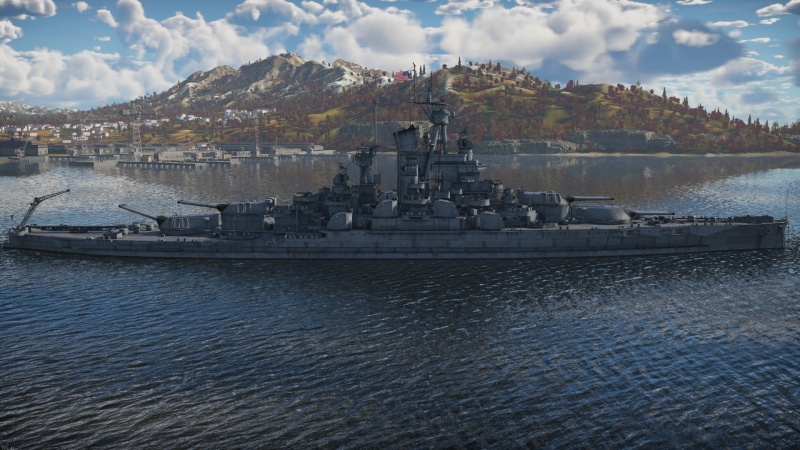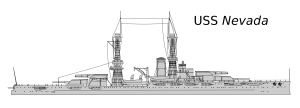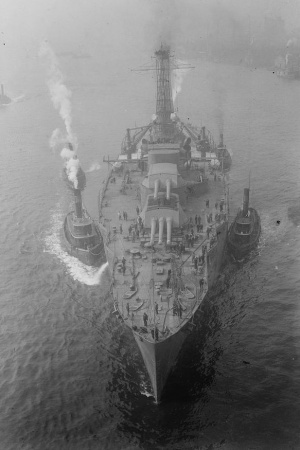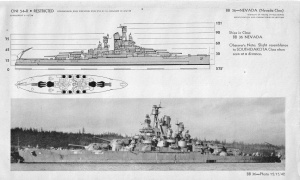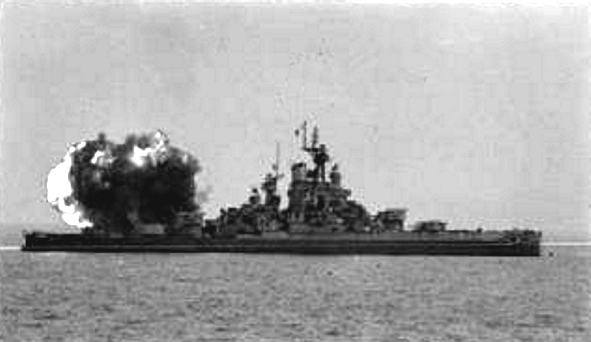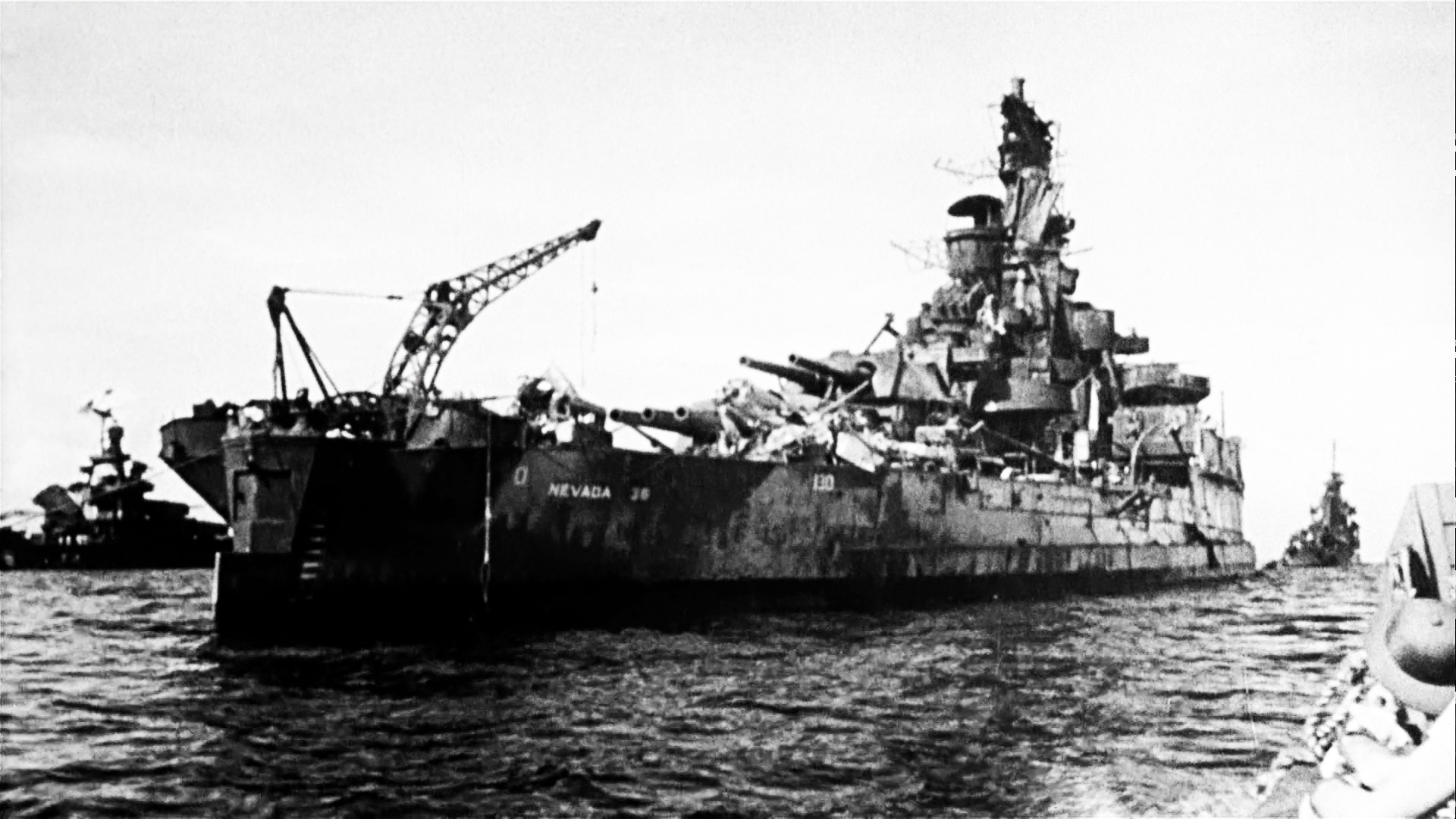Difference between revisions of "USS Nevada"
(→History) (Tag: Visual edit) |
(→Media) (Tag: Visual edit) |
||
| Line 105: | Line 105: | ||
<!-- ''Excellent additions to the article would be video guides, screenshots from the game, and photos.'' --> | <!-- ''Excellent additions to the article would be video guides, screenshots from the game, and photos.'' --> | ||
''Excellent additions to the article would be video guides, screenshots from the game, and photos.'' | ''Excellent additions to the article would be video guides, screenshots from the game, and photos.'' | ||
| + | |||
| + | [[File:USS Nevada.svg.png|left|frameless|Profile of ''Nevada'' before her 1927 refit]] | ||
| + | [[File:USS Nevada Towed.jpg|frameless]] | ||
| + | |||
| + | [[File:USS Nevada (BB-36) specs.jpg|none|thumb|Division of Naval Intelligence identification sheet depicting ''Nevada'' after her 1942 repair and modernization]] | ||
| + | [[File:USS Nevada (BB-36) bombarding Southern France 1944.jpg|frame]] | ||
| + | [[File:USS Nevada Post Operation Crossroads.png]] | ||
== See also == | == See also == | ||
Revision as of 20:45, 19 March 2023
Contents
Description
The Nevada-class, USS Nevada (BB-36), 1944 is one of two Nevada-class battleships built for the US Navy, laid down in 1912 and commissioned in 1916. USS Nevada was commissioned first, making her the first "Standard-Type" battleship. Her innovations would be carried forward into the future American battleships, including triple gun turrets and the introduction of the "all-or-nothing" armour scheme. She would serve with distinction through both World Wars, seeing extensive combat action during World War II in particular.
She was introduced into War Thunder in Update "Sky Guardians", and although having a slightly smaller main battery than the later USS Arizona, she stands out with her incredibly strong secondary and anti-aircraft batteries. Coming in her late war refit, USS Nevada gives American bluewater captains their first battleship with both strong firepower, and the ability to easily fend off air attack. This does come with the caveat of having at minimum a 40 second reload on the main battery; it's recommended to keep enemies at a distance where the long time between salvos can be mitigated.
General info
Survivability and armour
Talk about the vehicle's armour. Note the most well-defended and most vulnerable zones, e.g. the ammo magazine. Evaluate the composition of components and assemblies responsible for movement and manoeuvrability. Evaluate the survivability of the primary and secondary armaments separately. Don't forget to mention the size of the crew, which plays an important role in fleet mechanics. Save tips on preserving survivability for the "Usage in battles" section. If necessary, use a graphical template to show the most well-protected or most vulnerable points in the armour.
BB-36, also known as USS Nevada, was a battleship of the United States Navy. She was first in the United States Navy to adopt the All or Nothing Armor Scheme. One of its most significant contributions to naval warfare was the adoption of the "all or nothing" principle for armor placement. This principle involved placing maximum armor over critical areas, such as the magazines and engines, and no armor over less important areas. This design allowed for a significant increase in the overall armor on the battleship, with the armor accounting for 41.1% of the displacement. The "all or nothing" principle became widely adopted by major navies worldwide, reflecting its success in protecting critical areas of battleships.
|
Mobility
Write about the ship's mobility. Evaluate its power and manoeuvrability, rudder rerouting speed, stopping speed at full tilt, with its maximum forward and reverse speed.
| Mobility Characteristics | |||
|---|---|---|---|
| Game Mode | Upgrade Status | Maximum Speed (km/h) | |
| Forward | Reverse | ||
| AB | |||
| Upgraded | |||
| RB/SB | |||
| Upgraded | |||
Modifications and economy
Armament
Primary armament
Provide information about the characteristics of the primary armament. Evaluate their efficacy in battle based on their reload speed, ballistics and the capacity of their shells. Add a link to the main article about the weapon: {{main|Weapon name (calibre)}}. Broadly describe the ammunition available for the primary armament, and provide recommendations on how to use it and which ammunition to choose.
| Penetration statistics | |||||||
|---|---|---|---|---|---|---|---|
| Ammunition | Type of warhead |
Penetration @ 0° Angle of Attack (mm) | |||||
| 1,000 m | 2,500 m | 5,000 m | 7,500 m | 10,000 m | 15,000 m | ||
| Mk.9 HE | HE | 71 | 71 | 71 | 71 | 71 | 71 |
| Mk.8 APCBC | APCBC | 637 | 597 | 536 | 484 | 439 | 372 |
| Shell details | ||||||||||||
|---|---|---|---|---|---|---|---|---|---|---|---|---|
| Ammunition | Type of warhead |
Velocity (m/s) |
Projectile mass (kg) |
Fuse delay (s) |
Fuse sensitivity (mm) |
Explosive mass (TNT equivalent) (kg) |
Ricochet | |||||
| 0% | 50% | 100% | ||||||||||
| Mk.9 HE | HE | 823 | 635 | 0 | 0.1 | 46.67 | 79° | 80° | 81° | |||
| Mk.8 APCBC | APCBC | 823 | 635 | 0.035 | 17 | 15.24 | 48° | 63° | 71° | |||
Secondary armament
Some ships are fitted with weapons of various calibres. Secondary armaments are defined as weapons chosen with the control Select secondary weapon. Evaluate the secondary armaments and give advice on how to use them. Describe the ammunition available for the secondary armament. Provide recommendations on how to use them and which ammunition to choose. Remember that any anti-air armament, even heavy calibre weapons, belong in the next section. If there is no secondary armament, remove this section.
| Penetration statistics | |||||||
|---|---|---|---|---|---|---|---|
| Ammunition | Type of warhead |
Penetration @ 0° Angle of Attack (mm) | |||||
| 1,000 m | 2,500 m | 5,000 m | 7,500 m | 10,000 m | 15,000 m | ||
| AAC Mk.34 | HE | 36 | 36 | 36 | 36 | 36 | 36 |
| Common Mk.32 | Common | 124 | 103 | 77 | 58 | 46 | 37 |
| SP Common Mk.46 | SP Common | 150 | 125 | 93 | 71 | 56 | 45 |
| AAVT Mk.31 | HE-VT | 36 | 36 | 36 | 36 | 36 | 36 |
| Shell details | ||||||||||||
|---|---|---|---|---|---|---|---|---|---|---|---|---|
| Ammunition | Type of warhead |
Velocity (m/s) |
Projectile mass (kg) |
Fuse delay (s) |
Fuse sensitivity (mm) |
Explosive mass (TNT equivalent) (g) |
Ricochet | |||||
| 0% | 50% | 100% | ||||||||||
| AAC Mk.34 | HE | 792 | 25 | 0 | 0.1 | 3,220 | 79° | 80° | 81° | |||
| Common Mk.32 | Common | 792 | 24.49 | 0.01 | 6 | 1,150 | 47° | 60° | 65° | |||
| SP Common Mk.46 | SP Common | 792 | 25 | 0.01 | 6 | 906.5 | 48° | 63° | 71° | |||
| Proximity-fused shell details | ||||||||||||
|---|---|---|---|---|---|---|---|---|---|---|---|---|
| Ammunition | Type of warhead |
Velocity (m/s) |
Projectile mass (kg) |
Fuse delay (s) |
Fuse sensitivity (mm) |
Arming distance (m) |
Trigger radius (m) |
Explosive mass (TNT equivalent) (g) |
Ricochet | |||
| 0% | 50% | 100% | ||||||||||
| AAVT Mk.31 | HE-VT | 792 | 25 | 0 | 0.1 | 457 | 23 | 3,220 | 79° | 80° | 81° | |
Anti-aircraft armament
An important part of the ship's armament responsible for air defence. Anti-aircraft armament is defined by the weapon chosen with the control Select anti-aircraft weapons. Talk about the ship's anti-air cannons and machine guns, the number of guns and their positions, their effective range, and about their overall effectiveness – including against surface targets. If there are no anti-aircraft armaments, remove this section.
Scout plane
Usage in battles
Describe the technique of using this ship, the characteristics of her use in a team and tips on strategy. Abstain from writing an entire guide – don't try to provide a single point of view, but give the reader food for thought. Talk about the most dangerous opponents for this vehicle and provide recommendations on fighting them. If necessary, note the specifics of playing with this vehicle in various modes (AB, RB, SB).
Pros and cons
Summarise and briefly evaluate the vehicle in terms of its characteristics and combat effectiveness. Mark its pros and cons in the bulleted list. Try not to use more than 6 points for each of the characteristics. Avoid using categorical definitions such as "bad", "good" and the like - use substitutions with softer forms such as "inadequate" and "effective".
Pros:
Cons:
History
Describe the history of the creation and combat usage of the ship in more detail than in the introduction. If the historical reference turns out to be too long, take it to a separate article, taking a link to the article about the ship and adding a block "/History" (example: https://wiki.warthunder.com/(Ship-name)/History) and add a link to it here using the main template. Be sure to reference text and sources by using <ref></ref>, as well as adding them at the end of the article with <references />. This section may also include the ship's dev blog entry (if applicable) and the in-game encyclopedia description (under === In-game description ===, also if applicable).
World War I
Nevada was authorized for construction by an Act of Congress on March 4, 1911, and Fore River Shipbuilding Company was awarded the contract on January 22, 1912, for a total of $5,895,000 (excluding armor and armament). The initial construction period was set to be 36 months, but a secondary contract was signed on July 31, 1912, for an additional $50,000 to install a geared cruising unit on each propeller shaft, which extended the planned construction time by five months. The ship's keel was laid down on November 4, 1912, and as of August 12, 1914, it was 72.4% complete. Nevada was launched on July 11, 1914, and sponsored by Miss Eleanor Anne Seibert, the niece of Governor Tasker Oddie of Nevada and a descendant of Benjamin Stoddert, the first Secretary of the Navy. Several prominent government officials attended the launch, including Secretary of the Navy Josephus Daniels, Assistant Secretary of the Navy Franklin D. Roosevelt, Governor Oddie, Governor David I. Walsh of Massachusetts, and Senator Key Pittman of Nevada, who would later become a key figure in the US Senate.
World War II
On December 6, 1941, which happened to be a Saturday, all of the battleships in the Pacific Fleet were in port for the first time since July 4th. Typically, they would rotate spending time in port, with six ships out one weekend and three the next. However, on this particular weekend, Vice Admiral William Halsey Jr.'s aircraft carrier task force could not accommodate the slower battleships, and it was Vice Admiral William S. Pye's turn to rest in port, which was deemed a safe location. Therefore, none of the battleships were out sailing that morning. As the sun rose over Nevada on December 7th, the ship's band was playing "Morning Colors," but soon after, planes were spotted on the horizon, marking the beginning of the attack on Pearl Harbor.
During the attack on Pearl Harbor, Nevada was positioned behind Arizona and was not moored alongside another battleship off Ford Island, allowing it to maneuver unlike the other seven battleships that were present. Commander Francis W. Scanland, the ship's commanding officer, was ashore at the time of the attack, leaving Ensign Joe Taussig, the Officer of the Deck and son of an admiral with the same name, in charge. Earlier that morning, Taussig had ordered a second boiler to be lit, intending to switch the power load from one boiler to the other at 0800. At 0810, while Nevada's gunners were firing and her engineers were raising steam, a single 18-inch torpedo exploded against Frame 41, about 14 feet above the keel. The torpedo bulkhead held, but leaking through joints caused flooding of port side compartments below the first platform deck between frames 30 and 43, and a 4-5 degree list. However, Nevada's damage control crew was able to counter-flood and correct the list, allowing the ship to get underway at 0840. Thanks to Ensign Taussig's efficiency, the ship was likely saved, although he lost a leg in the attack. By this time, Nevada's gunners had already shot down four planes.
After being refloated on 12 February 1942, the USS Nevada was temporarily repaired in Pearl Harbor and then sent to Puget Sound Navy Yard for major repairs and modernization. Under the command of Captain Howard F. Kingman, the overhaul was completed in October 1942, and Nevada's appearance was changed to resemble a South Dakota battleship from a distance. During this modernization, her old guns were replaced with sixteen 5"/38 caliber guns in new twin mounts. Under the command of Captain Willard A. Kitts, Nevada sailed to Alaska to provide fire support for the capture of Attu from 11 to 18 May 1943. In June, she departed for Norfolk Navy Yard for further modernization.
See more at https://en.wikipedia.org/wiki/USS_Nevada_(BB-36)
Media
Excellent additions to the article would be video guides, screenshots from the game, and photos.
See also
Links to articles on the War Thunder Wiki that you think will be useful for the reader, for example:
- reference to the series of the ship;
- links to approximate analogues of other nations and research trees.
External links
| USA battleships | |
|---|---|
| Delaware-class | USS North Dakota |
| Wyoming-class | USS Wyoming · USS Arkansas |
| New York-class | USS Texas |
| Nevada-class | USS Nevada |
| Pennsylvania-class | USS Arizona |
| New Mexico-class | USS Mississippi |
| Tennessee-class | USS Tennessee |



